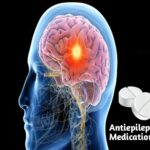List Of Top 50 Drugs To Avoid In Epilepsy

Epilepsy is a neurological disorder characterized by recurrent seizures. Seizures occur when there is abnormal electrical activity in the brain, which can cause a range of symptoms such as convulsions, loss of consciousness, and unusual sensations. Epilepsy can develop at any age and affects people of all races and ethnicities.
There are many different types of seizures and each person with epilepsy may experience a unique pattern of seizures. Some common types of seizures include focal seizures (which start in a specific part of the brain), generalized seizures (which affect the entire brain), and absence seizures (which cause a brief loss of consciousness).
Epilepsy can be caused by a variety of factors, such as genetic predisposition, brain injury, infections, and brain tumors. According to the World Health Organization (WHO), it affects approximately 50 million people worldwide. In the United States, it is estimated that 1 in 26 people will develop epilepsy at some point in their lifetime. The prevalence of epilepsy varies by country and region, with higher rates reported in low- and middle-income countries.
Drug-induced Epilepsy Seizures
Drug-induced epilepsy seizures are seizures that are caused by the use of certain medications or drugs. This can occur as a side effect of the drug or as a result of an overdose.
Many drugs have the potential to cause seizures. The risk of developing seizures is often related to the dose and duration of use of the drug, as well as individual factors such as age, underlying medical conditions, and genetics.
In some cases, drug-induced seizures may be a sign of an underlying condition that needs to be addressed. For example, seizures caused by drug withdrawal may indicate a dependence or addiction to the drug, while seizures caused by a brain infection may require specific treatment with antibiotics or antiviral drugs.
List Of Drugs To Avoid In Epilepsy
The list of drugs to avoid in epilepsy may vary depending on the individual’s specific condition and other factors such as age, medical history, and other medications the person is taking. However, here is a list of 20 drugs that are generally known to be problematic in epilepsy:
1. Tramadol: This pain reliever can lower the seizure threshold and increase the risk of seizures. Examples include Ultram, ConZip, and Rybix.
2. Bupropion: This antidepressant can lower the seizure threshold and increase the risk of seizures. Examples include Wellbutrin, Zyban, and Aplenzin.
3. Clozapine: This antipsychotic medication can increase the risk of seizures. Examples include Clozaril and FazaClo.
4. Chlorpromazine: This antipsychotic medication can lower the seizure threshold and increase the risk of seizures. Examples include Thorazine and Largactil.
5. Metoclopramide: This medication used to treat nausea and vomiting can lower the seizure threshold and increase the risk of seizures. Examples include Reglan and Maxolon.
6. Mirtazapine: This antidepressant can lower the seizure threshold and increase the risk of seizures. Examples include Remeron and Zispin.
7. Isoniazid: This medication used to treat tuberculosis can lower the seizure threshold and increase the risk of seizures. Examples include Nydrazid and Laniazid.
8. Lithium: This mood stabilizer can increase the risk of seizures. Examples include Eskalith and Lithobid.
9. Theophylline: This medication used to treat asthma can lower the seizure threshold and increase the risk of seizures. Examples include Theolair and Uniphyl.
10. Meperidine: This pain reliever can lower the seizure threshold and increase the risk of seizures. Examples include Demerol and Pethidine.
11. Carbapenems: This class of antibiotics can lower the seizure threshold and increase the risk of seizures. Examples include Meropenem, Imipenem, and Ertapenem.
12. Cephalosporins: This class of antibiotics can lower the seizure threshold and increase the risk of seizures. Examples include Cefepime, Ceftriaxone, and Cefixime.
13. Imipenem: This antibiotic can lower the seizure threshold and increase the risk of seizures. Examples include Primaxin.
14. Penicillin G: This antibiotic can lower the seizure threshold and increase the risk of seizures. Examples include Penicillin G and Bicillin.
15. Quinolones: This class of antibiotics can lower the seizure threshold and increase the risk of seizures. Examples include Ciprofloxacin, Levofloxacin, and Ofloxacin.
16. Antimalarials: This class of medications used to treat malaria can lower the seizure threshold and increase the risk of seizures. Examples include Chloroquine and Quinine.
17. Antihistamines: This class of medications used to treat allergies can lower the seizure threshold and increase the risk of seizures. Examples include Diphenhydramine and Promethazine.
18. Antidepressants: Certain types of antidepressants can lower the seizure threshold and increase the risk of seizures. Examples include Amitriptyline, Nortriptyline, and Doxepin.
19. Antipsychotics: Certain types of antipsychotics can lower the seizure threshold and increase the risk of seizures. Examples include Haloperidol, Risperidone, and Olanzapine.
20. Alcohol: Drinking alcohol can increase the risk of seizures.
It is important to note that this is not a comprehensive list and that there may be other drugs or substances that can increase the risk of seizures in individuals with epilepsy. Additionally, some of the drugs listed above may be used in certain circumstances, such as when there are no alternative treatments available or when the benefits of the medication outweigh the potential risks. It is important to discuss any concerns about medication with a healthcare provider to determine the best course of action. In some cases, adjusting the dosage or frequency of medication may help to reduce the risk of seizures. It is also important for individuals with epilepsy to avoid other triggers that can increase the risk of seizures, such as stress, lack of sleep, and certain types of flashing lights. Maintaining a healthy lifestyle and following a treatment plan as prescribed by a healthcare provider can help to minimize the frequency and severity of seizures.
How To Safely Take Medications With Epilepsy
If you have epilepsy and need to take medications, it is important to take them safely to avoid triggering seizures. Here are some tips for safely taking medications with epilepsy:
1. Talk to your doctor: Before starting any new medication, talk to your doctor about your epilepsy and any medications you are currently taking. This will help your doctor determine which medications are safe for you to take and at what dosage.
2. Take medications as prescribed: It is important to take medications exactly as prescribed by your doctor. Do not skip doses or stop taking medications without first consulting with your doctor.
3. Avoid medications that lower seizure threshold: As previously mentioned, some medications can lower the seizure threshold and increase the risk of seizures. Avoid taking these medications unless your doctor has prescribed them specifically for your condition.
4. Keep a record of your medications: Keep a list of all the medications you are taking, including over-the-counter medications, vitamins, and supplements. This will help your doctor monitor your medication use and avoid any potential interactions.
5. Take medications with food: Some medications can cause nausea or stomach upset. Taking medications with food can help to reduce these side effects.
6. Monitor for side effects: Some medications can cause side effects, such as drowsiness, dizziness, or changes in mood. If you experience any side effects, talk to your doctor about adjusting the dosage or switching to a different medication.
7. Avoid alcohol and recreational drugs: Alcohol and recreational drugs can increase the risk of seizures. It is important to avoid these substances when taking medications for epilepsy.
8. Get enough sleep: Lack of sleep can increase the risk of seizures. Make sure to get enough sleep each night and follow a regular sleep schedule.
9. Use caution when driving or operating machinery: Some medications can cause drowsiness or dizziness, which can impair your ability to drive or operate machinery. Make sure to use caution when engaging in these activities.
10. Wear a medical alert bracelet: In case of an emergency, wearing a medical alert bracelet can help first responders to quickly identify your condition and provide appropriate care.
By following these tips, you can safely take medications with epilepsy and minimize the risk of triggering seizures. It is important to work closely with your doctor to manage your epilepsy and medication use.





